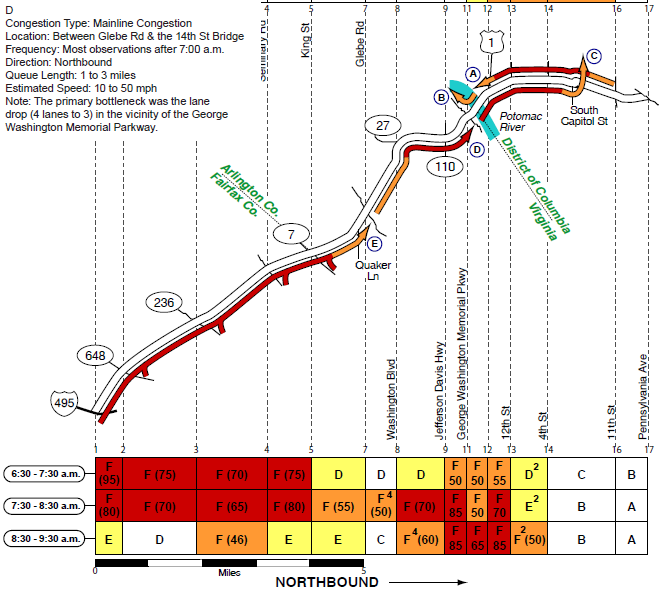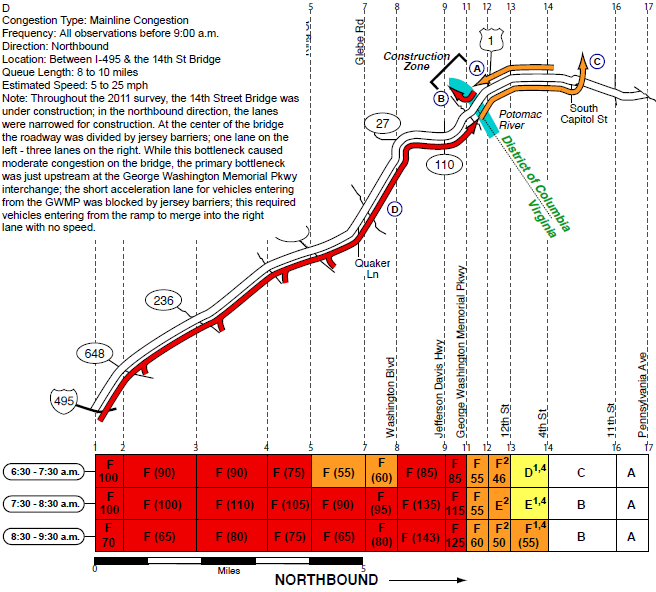A World Without Metro, Part 1: I-395 Traffic
Metro’s new strategic planning process, Momentum, articulates a vision for the the next generation of Metro. One way to illustrate Metro’s vital role in the region’s transportation network is to show the impact of not having Metro. This series will give perspective on the many real benefits that Metro conveys to the region today.
Metrorail’s Yellow Line crosses the Potomac from Virginia into DC parallel to I-395’s 14th Street Bridge. Both the rail and highway bridges move large numbers of people into the regional core during the morning rush hour. Between the two inbound spans, the 14th Street Bridge has six lanes. The Yellow Line provides the equivalent of three additional lanes. This math is pretty simple: one lane of freeway traffic can move about 2,420 people per hour (2,200 vehicles per hour times an average auto occupancy of 1.1 people per car) and the Yellow Line moves around 7,400 passengers from Pentagon to L’Enfant Plaza during the peak AM hour. Another way to see it is that the Yellow Line removes 6,700 (7,400 pax / 1.1 pax per car) cars from the road.
What would happen to I-395 if some or all of the in-bound Metrorail Yellow Line customers switched to driving in the morning?
If only 5% of Yellow Line customers drove up the freeway to the 14th Street Bridge during the AM peak hour, I-395 would fill with stop-and-go traffic for ten miles.

Map illustrating regularly recurring three-mile queue and the 10-mile queue that would regularly form if only 5% of the inbound AM commuters on the Yellow Line across the Potomac River switched to driving.
How is this possible?
Currently I-395 northbound traffic backs up in the AM due to a lane drop near the interchange between I-395 and the George Washington Parkway: the mainline roadway goes from four lanes to three, dropping the capacity from 8,800 vph (vehicles per hour) down to 5,850 vph. The current level of demand is approximately 7,500 vph: 5,850 vehicles pass through the bottleneck in the hour and the rest get stuck in a queue that spills back for three miles, to South Glebe Road just north of Shrlington. The graphic below from the 2008 Aerial Traffic Congestion Survey documents this recurring congestion.

Recurring mainline AM congestion northbound on I-395 to the 14th Street Bridge, from the 2008 Aerial Traffic Congestion Survey.
Adding to the demand by taking customers off the Yellow Line and putting them onto I-395 would make the queue grow faster and longer. By adding only 340 vehicles to the roadway during the peak hour (5% of the Yellow Line passengers), the queue would grow to a length of 10 miles, to Springfield near the interchange of I-95 and Franconia Road.
How realistic is a 10-mile queue? Very.
Commuters in the I-395 corridor between 2009 and 2011 may remember construction on the 14th Street Bridge. This construction was well underway during the 2011 Aerial Traffic Congestion Survey, which recorded traffic queues between 8 to 10 miles long on I-395 during the AM peak hour. The construction did not even remove a lane but only a merge area, which was enough to reduce the throughput of the bridge significantly and cause a lot of delay to a lot of people. While this queue was caused by a reduction in capacity, it is the identical to what would result from an increase in demand caused by travelers switching from rails to roads.

Extensive recurring mainline congestion northbound on I-395 to the 14th Street Bridge, from the 2011 Aerial Traffic Congestion Survey. Excessive queues were caused by reconstruction of the bridge.
Metro is working hard to maintain our rails and bridges through our Metro Forward capital rebuilding campaign, to ensure that Metro will continue to provide an efficient option to DC-area commuters and help mitigate congestion on our roadways.
Over 40 years ago, regional leaders decided that Metrorail was preferable to covering the national capital with freeways. Today, Metrorail Yellow Line moves nearly as many people into the regional core during the peak hour as three lanes of the I-395 14th Street Bridge. This region is again faced with a choice if we are going to continue to have a strong regional core: build the freeways we opted against 40 years ago, or invest in the transit network that also helps keep congestion at bay.


Recent Comments